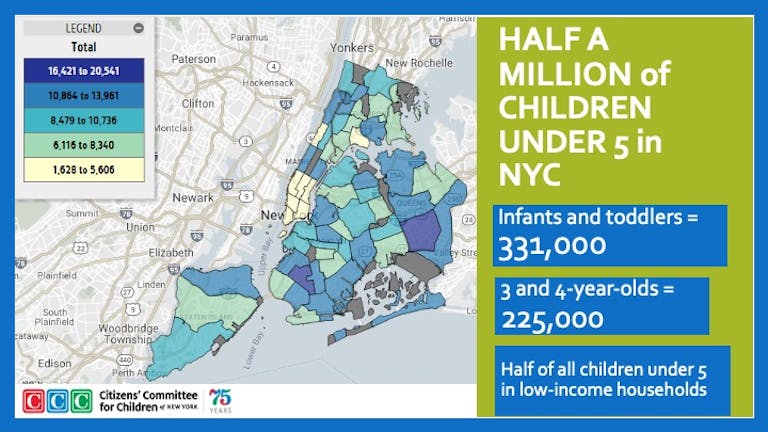

Positioning NYC’s Early Care and Education System for a Successful Long-term Recovery
Digital Briefs
July 16, 2020
As New York City continues its progress towards reopening its economy, what remains unclear is how early care and education centers and providers will be able to reopen to support parents going back to work. Although centers can reopen on July 13th, its uncertain how many are able to do so. Many providers were forced to close during the Spring, either due to financial constraints or by law, and those that were able to stay open may be holding on by a thread. Reopening places an additional financial burden on providers to both follow safety guidelines and do so with limited capacity for children.
In addition to the challenges in reopening safely, early care providers will need to adapt their services to accommodate our new reality. Services will need to be offered both in-person and remotely to safely practice social distancing. Early child care as a service must shift to meet the unique demands of our current health, social, and economic crises. As the city plans for a long recovery, early care and education will serve a vital role helping parents and caregivers return to work, promoting healthy child development, and mitigating the impact of trauma on children.
Early Care Capacity Before The Pandemic
In a CCC analysis of the early child care sector based on enrollment data from 2018, of the 548,000 children under 5 in New York City, only 123,000 or 22% were enrolled in the city’s publicly-funded system. Even before the pandemic hit, there was glaring need for affordable care.

Source: CCC analysis of U.S. Census Bureau, American Community Survey (2018). Retrieved from the Keeping Track Online Database.
That need is most acute for younger children. Of the population of children under 5 in NYC, nearly 60% or over 330,000 were infants and toddlers (birth to three years of age). And yet only 23,104 infants and toddlers or 7% were in some type of publicly-funded child care setting in 2018. Options are particularly scarce for children under 3, despite it being the most crucial years of a child’s development. Even when schools, centers and family day cares are operating at capacity, the working families of New York still have so much need for high-quality affordable early care that is not being met.
Ages of Children in Publicly-Funded Early Care
Source: CCC Analysis of child care enrollment data from the New York City Administration for Children’s Services Child Care Data (February 2018) and New York City Department of Education Demographic Snapshots (SY 2017/2018). Retrieved from the Keeping Track Online Database.
Children in Publicly-Funded Early Care by Type of Setting
Source: CCC Analysis of child care enrollment data from the New York City Administration for Children’s Services Child Care Data (February 2018) and New York City Department of Education Demographic Snapshots (SY 2017/2018). Retrieved from the Keeping Track Online Database.
COVID-19 Impact
When the Dept. of Education closed schools it also closed its contracted early care centers run by CBOs. The Department of Health and Mental Hygiene followed by closing all centers, but family child programs that operate out of homes have been allowed to stay open, if they were able to do so.
At the same time schools and centers were shutting down so was New York City’s economy. The City’s seasonally-adjusted unemployment rate hit 18.3% in May, as hundreds of thousands of jobs evaporated and families were thrown into income, housing and food instability.
The loss of jobs and closing of early care settings have compounded to create an environment where New York families cannot return to work or seek new employment until they have options for safe, affordable and accessible early child care. In data collected by the U.S. Census Bureau from April to May, one in ten adults living with children reported they could not work because they were caring for children who were not in school/day care.
Main reason for not working in the past week
CCC analysis of US Census Bureau, Household Pulse Survey data (April 23-May26)
We know we need early care to get people back to work, but we also need it to help children cope with possible traumatic experiences in healthy ways as a result of this crises. In reopening the sector, the city must prioritize several areas in order to have early care and education be a part of a successful recovery.
Priorities For A Recovery
Integrate Early Intervention And Meet Children’s Social-Emotional Needs
Considering trauma children may experience from COVID-19, it will be important to integrate behavioral health supports in ECE settings, including through trauma-informed care, behavioral health, and Early Intervention services. The city must equip educators, administrators and ECE staff with support and effective tools to identify, assess and address children’s trauma, and the state and DOHMH must work to ensure children receive appropriate screenings, referrals, and evaluations through Early Intervention services and to behavioral health care.
Protect Universal Pre-K And 3K Capacity With Extended-Day Learning
The growth and success of the city’s universal Pre-K system for 4-year-olds cannot be undone due to our current crisis. Families have come to rely on the high-quality and free care options through UPK, and its capacity, quality and availability will be crucial to get people back to work. Although limiting in-person capacity at certain times will be necessary to ensure social distancing, the goal must be to continue to offer services to as many families as possible and not to sacrifice capacity in the city’s Pre-K networks. The same can be said for the city’s ongoing expansion of 3K, and in districts where 3K already serves families, the administration must ensure that seats are not lost.
Effective recovery will also require a continued commitment to quality services all day with adequate extended-day options for contracted providers. With providers ability to be flexible in their service hours to accommodate staff and capacity, the city must ensure extended day options are maintained for working families requiring care from 3-6 PM.
Protect And Expand Infant And Toddler Care Capacity With An Eye Towards Helping Family Child Care Providers
Before the COVID-19 crisis, the city had a scarcity of publicly supported options for infants and toddlers. According to CCC’s analysis of the U.S. Census American Community Survey, as of 2018, around 148,000 of these children lived in households earning less than 200% of the federal poverty level. Despite this high number of young children who are subsidy eligible, only 23,104 infants and toddlers or 16% were enrolled in publicly-funded care. With parents returning to work, ensuring supporting and expanding infant/toddler care is vital to recovery.
Most of the infant/toddler care in the city is within the homes of licensed family child care providers. The Administration must also ensure that these providers, many of whom attempted to stay open to serve their clients but suffered financially, are made whole and supported, through both encouragement of state grant opportunities as well as leveraging available federal and city funds
Prioritize Early Care Services For Essential Workers And Vulnerable Populations
Forecasting a long recovery and the potential for repeated strain on the healthcare and emergency response systems with another virus outbreak, we must continue to prioritize and protect early care services for essential workers in NYC. This means that although most schools and early care centers will be adopting blended learning models in the fall, there still needs to be full-day in-person services offered every day of the week to ensure the essential workforce still has options for their children.
Additionally, when the city instructs centers in how to prioritize families for in-person services, preference should be given to vulnerable populations of children with obstacles to successful remote engagement, such as children living in homeless shelters or doubled-up in housing.
Honor The City’s Commitment To Salary Parity
After many years of tireless advocacy, the city did the right thing and committed to fund salary increases for early childhood educators who comprise the backbone of the city’s publicly funded early care and education system. The Administration must continue to honor this commitment and build on the progress made by seeing through the scheduled salary increases this fall, and ensuring parity is part of future labor negotiations with center-based providers. Additional consideration should be made towards increasing the salaries of family day care providers
Support The Development Of Virtual Programming For Young Children.
Just as providers offered early care services virtually during the early months of the pandemic, if blended in-person and remote models are the service delivery options adopted by most providers as they reopen, there must be continued support to help them deliver high-quality and developmental virtual programming for young children.
Reopening the city’s economy hinges on accessible and affordable early care and education in NYC, and the City’s long-term recovery requires long-term commitment and investments in the sector, its workforce, providers, and child and family programming and supports.




